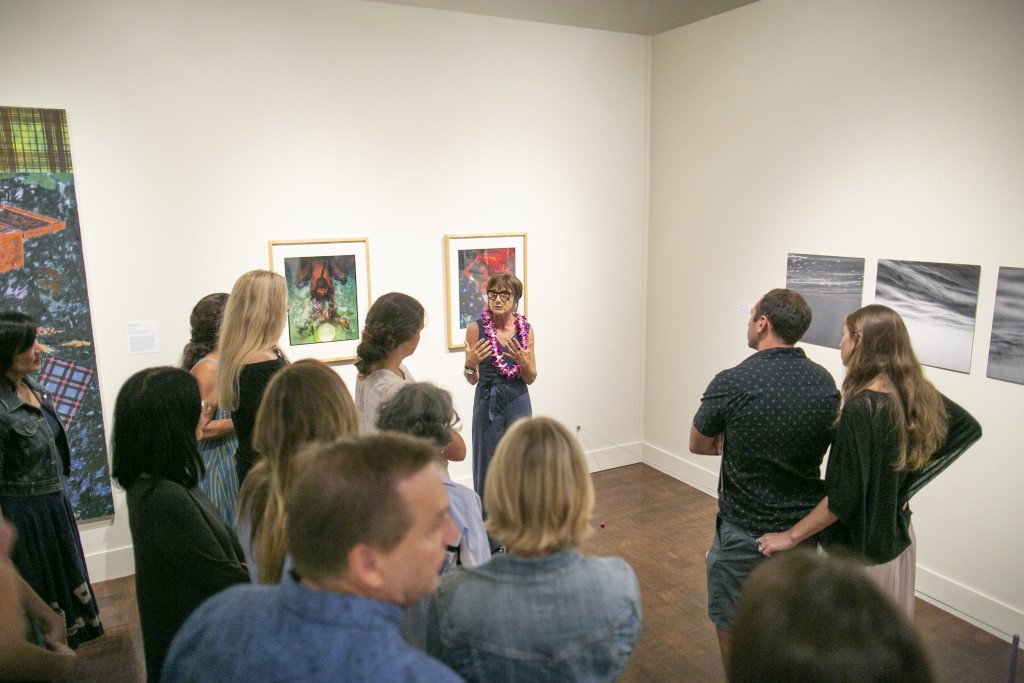By Kathleen Wong
Honolulu Museum of Art Blog, January 2018
Hailing from Croatia, Bruna Stude grew up in a family “that infused art in every aspect of our life.” Her sister was a classical ballerina. Her grandfather an artist. Since she felt that “two artists would have been one too many,” she decided to pursue law at university while continuing to work on her art on the side. After graduating, she was given the opportunity to join the crew of a private boat. What was supposed to be a summer job turned into a 20-year photography project.
“I used to say the ocean is my ink with which I draw,” Hawai?i-living Stude said. One look at her body of work, entitled Empty Ocean, and you’d wholeheartedly agree. Stude’s deep and complex relationship with the ocean is expressed through black-and-white photographs that seek to depict the harrowing reality of the ocean and its gradual loss of vibrant life.
Part of that project can be seen right here at the museum’s exhibition Making Waves, on view now until Feb. 3.
We spoke to Stude on the phone to learn more about what inspired her career in photographer and about her artistic process itself.
What is your background with art and the ocean and how did the two intersect?
Living and working on a boat enabled me to travel to some of the most remote corners of the world. It was all private and these people were really passionate about the ocean and, especially the last seven years, all we did was followed the dive season. We circumnavigated the globe three, four times… All this travel and these experiences enabled me to see the changes… I was able to see with my own eyes the changes, like the bleaching of the coral in the Maldives. It’s the reality. We heard dynamiting of the reefs in the Philippines. So all of that really influenced my work.

Tell me about how Empty Oceans began.
I went to the Honduras to photograph whale sharks and to be an ambassador for the sharks because we are losing them at a pace that I don’t think we can ever change. I wanted to create a life-sized portrait of the whale shark, just to be an ambassador for the shark because people don’t know enough. We would go everyday on the boat looking for whale sharks in the peak of the season. I would do the test shots of the ocean so I’d be ready when the whale sharks arrived, I’d be prepared, I’d have all my apertures. And 10 days later, I ended up with a roll of film. They were all the frames of the empty ocean. We had not seen one whale shark in 10 days. That changed everything for me. That changed the direction of my work, and I also realized the impact because me showing intimate portraits of the coral or anything along those lines showed much less impact.
What are some challenges to photographing underwater compared to on land?
That is where I’m really comfortable at. It’s a really great excuse to get wet. The challenges are you have all the elements in photography that you’d have on the land plus everything moves and you move and there’s a weather element to it. It is the opposite of the studio photography because everything is subject to change and everything is challenging [Through my experience, I have learned that the] ocean has a lot of particles. Even when your eye sees this beautiful body of water that’s clear and spectacular in its beauty, the camera sees particles and reflections—and they don’t necessarily happen to be in the place that you call happy accidents when you look in the frame. That was one of my main challenges of photographing underwater. What I decided was to try and take advantage of it. Instead of trying to avoid it, I was trying to focus on it. By moving my camera in a gesture similar to gestural paintings and utilizing all these particles and their reflections, I started to create underwater drawings with light. So my new work is a little different than what you would see in the show.